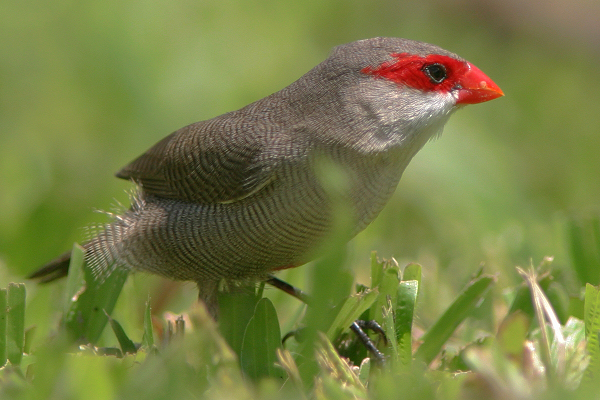Common Waxbill
From Wikipedia, the free encyclopedia
Order: Passeriformes
Family: Estrildidae
[Photo] Common Waxbill (Estrilda astrild). Date: 12 July 2005. Author: Andr?? Simons. Source: http://en.wikipedia.org/wiki/Image:Estrilda_astrild_2.jpg Copyright (C) 2005 Andr?? Simons
Permission is granted to copy, distribute and/or modify this document under the terms of the GNU Free Documentation License, Version 1.2 or any later version published by the Free Software Foundation; with no Invariant Sections, no Front-Cover Texts, and no Back-Cover Texts. A copy of the license is included in the section entitled "GNU Free Documentation License". |
The Common Waxbill (Estrilda astrild), also known as St Helena Waxbill, is a small passerine bird belonging to the estrildid finch family. It is native to sub-Saharan Africa but has been introduced to many other regions of the world and now has an estimated global extent of occurrence of 10,000,000 km². It is popular and easy to keep in captivity.
Description
It is a small bird, 11 to 13 centimetres in length with a wingspan of 12 to 14 centimetres and a weight of 7 to 10 grams. It has a slender body with short rounded wings and a long graduated tail. The bright red bill of the adult is the colour of sealing wax giving the bird its name. The plumage is mostly grey-brown, finely barred with dark brown. There is a red stripe through the eye and a reddish stripe along the centre of the belly. The cheeks and throat are whitish and there is often a pinkish flush to the underparts. The rump is brown and the tail and vent are dark. Females are similar to the males but are paler with less red on the belly. Juveniles are duller with little or no red on the belly, fainter dark barring and a black bill.
Similar species include the Black-rumped, Crimson-rumped and Black-lored Waxbills. The Black-rumped Waxbill is black rather than brown on the rump and has a pale vent (area underneath the tail). The Crimson-rumped Waxbill has a dark bill, red rump and some red on the wings and tail. The Black-lored Waxbill (found only in the Democratic Republic of Congo) has a black rather than red stripe through the eye.
The Common Waxbill has a variety of twittering and buzzing calls and a distinctive high-pitched flight-call. The simple song is harsh and nasal and descends on the last note.
Distribution and habitat
Native range
There are about 17 subspecies distributed widely across much of Africa south of the Sahara. They are present in most parts of East, Central and Southern Africa except for regions of desert or dense forest. In West Africa they are more local with the main population centred on Sierra Leone, Liberia and the Ivory Coast. Common Waxbills inhabit open country with long grass and rank vegetation. They are often found near water in marshes and among reeds. They can be tame and will enter gardens, parks and farmland.
Introduced range
Birds have often escaped from captivity or been deliberately released. Breeding populations have become established in many places where the climate is sufficiently warm. They are now found on many islands around Africa: Saint Helena, Ascension Island, the Cape Verde Islands, S??o Tom?? and Pr??ncipe, Mauritius, R??union, Rodrigues and the Seychelles. They may possibly be native on some of these islands. In Europe the Common Waxbill has become widespread in Portugal and is spreading through Spain. There are small populations on Madeira and Gran Canaria and it has recently appeared on Tenerife and the Azores. In the Americas waxbills are found in Trinidad, several parts of Brazil and there are a few on Bermuda. In the Pacific there are populations on New Caledonia, Efate Island in Vanuatu, Tahiti and the Hawaiian Islands.
Reproduction
The nest is a large ball of criss-crossed grass stems with a long downward-pointing entrance tube on one side. It is built in a cavity, usually low down amongst dense vegetation. A rudimentary second nest ("cock's nest") may be built on top where the male sleeps. Four to seven white eggs are laid. They are incubated for 11 to 13 days and the young birds fledge 17 to 21 days after hatching. Both parents take part in incubating the eggs and feeding the chicks. The timing of the breeding season varies in different parts of the world. Nests may be parasitized by the Pin-tailed Whydah which lays its eggs in the nests of estrildid finches. In captivity they will breed in an aviary and can raise four broods in a year.
Feeding
The diet consists mainly of grass seeds but insects are also eaten on occasions, especially during the breeding season when more protein is needed. The waxbills typically forage in flocks which may contain hundreds or even thousands of birds. They usually feed by clinging to the stems with their long, spindly claws and picking from the flower heads but they will also search for fallen seeds on the ground. They need to drink regularly as the seeds contain little water.
http://en.wikipedia.org/wiki/Common_Waxbill
| The text in this page is based on the copyrighted Wikipedia article shown in above URL. It is used under the GNU Free Documentation License. You may redistribute it, verbatim or modified, providing that you comply with the terms of the GFDL. |
|

